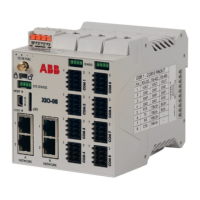120 | XIO USER MANUAL | 2106424MNAA
8.3 Denial of service (DOS) threshold rates
Protection of ports used for TCP/IP communication, such as Ethernet, is very important. Cybersecurity
threats can make a device unavailable for connection.
If the Totalflow device has a Denial of Service (DOS) attack, the device cannot grant requests for
connection. It stops responding. The following table provides the DOS threshold rates per packet type.
The device stops responding at these thresholds.
Table 8-5: Denial of Service (DOS) threshold rates
9 Mbps (13393 packets/sec)
9 Mbps (13393 packets/sec)
9 Mbps (13393 packets/sec)
27 Mbps (40179 packets/sec)
10 Mbps (14881 packets/sec)
10 Mbps (14881 packets/sec)
8.4 Security guidelines
The following table contains recommended guidelines to secure access to the XIO. Find procedures for
secure configuration throughout this manual, in Quick Start Guides, and in online PCCU help files.
Table 8-6: XIO security guidelines
Secure physical acces
to the device
Control access to the device, internal components, and connected peripherals.
Secure access with
security switch
Turn the onboard security switch on to enforce authentication through bi-level security
codes or RBAC.
section 8.5.
Configure bi-level
security
codes
Change default security codes to private codes (the default security code for both level
and level 2 is 0000).
section 8.5.
Enable Role-Based
Access Control (RBAC
section 8.6.
role-based access and enable authentication for each of the communication po
he default RBAC passwords and security codes.
Secure network
connection
The device only connects to a firewall-protected private network. Do not connect directl
to the Internet.
®
Enable Bluetooth only when required.
Enable RBAC authentication on the port.
section 8.6.

